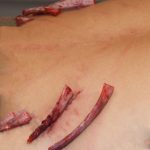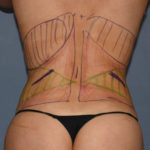Rib removal for waistline narrowing involves the selective removal of key portions of the ribs to allow the anatomic waist to become circumferentially smaller. While the circumferential waistline measurement may become reduced by variable amounts, the more important visual assessment is an inward indentation at the sides of the anatomic waist creating the so called hourglass effect.
To achieve this waistline effect through this surgical procedure, removal or modifications of the so called false ribs is needed. To understand how this exactly works it is important to review some basic anatomy of the influence of the ribcage on the waistline.
The ribcage, also called the thoracic cage, is comprised of the posterior vertebral column, the anterior sternum and the ribs that connect the two around the sides. Most humans have 24 ribs, 12 on each side, and costal cartilages that connect some of the ribs to the sternum. Of the 12 ribs, the upper seven are called the true or fixed ribs because they are directly attached to the sternum. (vertebrosternal ribs) The lower five ribs (8 through 12) are called the false ribs since they have no direct connection to the sternum. (vertebrochondral ribs) Ribs eight through ten do connect indirectly to the sternum through long cartilage connections. The lower eleven and twelve ribs, also known as the floating ribs, are so called because they are only connected to the vertebral column with free floating catilaginous ends.
They are numerous variations to this rib count with the presence of extra ribs or even missing ribs in some people. The tenth rib can also be a floating rib without any cartilaginous connection to the seventh rib and is most commonly seen in the Japanese population.

One question about rib removal is whether a portion or all of the rib needs to be removed. There is also the consideration of whether the bony or cartilaginous portion of the rib needs to be actually removed or whether reshaping by bony osteotomies or cartilaginous cuts may suffice. This must be decided on an individual case basis considering the location of the planned rib removal and whether one is going to undergo after surgery waistline training by garments.
Dr. Barry Eppley
Indianapolis, Indiana



